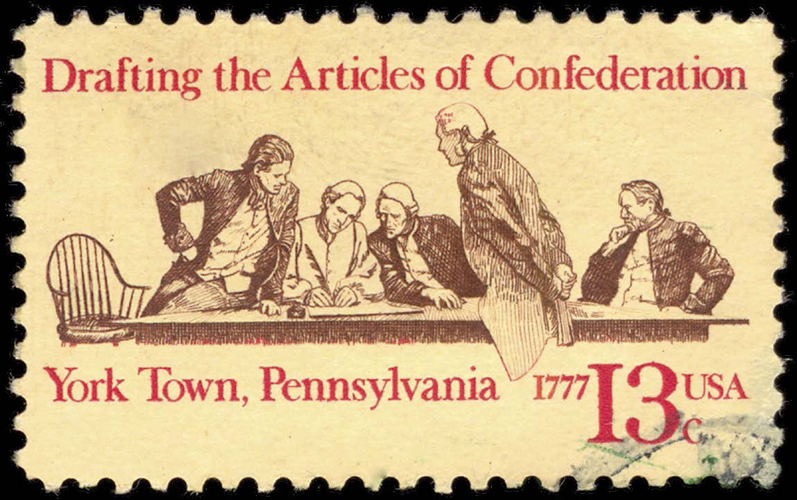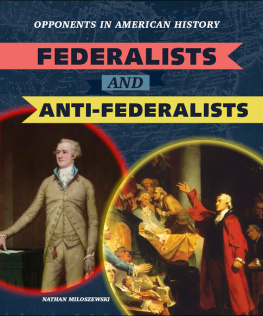Contents
Published in 2020 by The Rosen Publishing Group, Inc. 29 East 21st Street, New York, NY 10010
Copyright 2020 by The Rosen Publishing Group, Inc.
All rights reserved. No part of this book may be reproduced in any form without permission in writing from the publisher, except by a reviewer.
First Edition
Editor: Jane Katirgis
Book Design: Tanya Dellaccio
Photo Credits: Cover (left) GraphicaArtis/Archive Photos/Getty Images; cover (right), pp. 5 (constitutional convention), 19, 21 Fotosearch/Archive Photos/Getty Images; p. 5 (map) Bettmann/Getty Images; p. 7 https://upload.wikimedia.org/wikipedia/commons/9/9d/Scene_at_the_Signing_of_the_Constitution_of_the_United_States.jpg; p. 9 (Articles of Confederation) Courtesy of Our Documents; p. 9 (drafting of the Articles of Confederation) artnana/Shutterstock.com; p. 11 (Alexander Hamilton) https://upload.wikimedia.org/wikipedia/commons/0/05/Alexander_Hamilton_portrait_by_John_Trumbull_1806.jpg; p. 11 (Ben Franklin) https://upload.wikimedia.org/wikipedia/commons/2/25/Benjamin_Franklin_by_Joseph_Duplessis_1778.jpg; p. 11 (John Adams) https://upload.wikimedia.org/wikipedia/commons/9/9e/Johnadamsvp.flipped.jpg; p. 11 (James Madison) https://upload.wikimedia.org/wikipedia/commons/1/1d/James_Madison.jpg; p. 11 (John Jay) https://upload.wikimedia.org/wikipedia/commons/7/72/John_Jay_%28Gilbert_Stuart_portrait%29.jpg; p. 13 (George Mason) https://upload.wikimedia.org/wikipedia/commons/b/bb/George_Mason_portrait.jpg; p. 13 (James Monroe) https://upload.wikimedia.org/wikipedia/commons/9/95/James_Monroe_White_House_portrait_1819.gif; p. 13 (Samuel Adams) https://upload.wikimedia.org/wikipedia/commons/8/89/J_S_Copley_-_Samuel_Adams.jpg; p. 13 (Patrick Henry) https://upload.wikimedia.org/wikipedia/commons/e/ea/Patrick_henry.JPG; p. 17 Pigrox/Shutterstock.com; p. 23 (illustration) Universal History Archive/Universal Images Group/Getty Images; p. 23 (The Federalist) https://upload.wikimedia.org/wikipedia/commons/c/c7/The_Federalist_%281st_ed%2C_1788%2C_vol_I%2C_title_page%29_-_02.jpg; p. 25 (top) Alan Budman/ Shutterstock.com; p. 25 (bottom) f11photo/Shutterstock.com; p. 27 (James Madison) Everett Historical/ Shutterstock.com; p. 27 (Bill of Rights) https://upload.wikimedia.org/wikipedia/commons/7/79/Bill_of_Rights_Pg1of1_AC.jpg; p. 29 https://upload.wikimedia.org/wikipedia/commons/5/59/Kings_County_Courthouse_%28Kingston_Free_Library%29.jpg.
Cataloging-in-Publication Data
Names: Miloszewski, Nathan.
Title: Federalists and anti-federalists / Nathan Miloszewski.
Description: New York : PowerKids Press, 2019. | Series: Opponents in American history | Includes glossary and index.
Identifiers: ISBN 9781538345405 (pbk.) | ISBN 9781538343678 (library bound) | ISBN 9781538345412 (6 pack)
Subjects: LCSH: Federalist--Juvenile literature. | Constitutional history--United States--Juvenile literature. | Federal government--United States--History--18th century--Juvenile literature. | United States--Politics and government-1783-1789--Juvenile literature.
Classification: LCC KF4515.M556 2019 | DDC 342.73024--dc23
Manufactured in the United States of America
CPSIA Compliance Information: Batch #CSPK19. For Further Information contact Rosen Publishing, New York, New York at 1-800-237-9932
AFTER THE REVOLUTIONARY WAR
Picture yourself in the mid-1780s. The American Revolutionary War was over. After declaring independence from Great Britain in 1776 and winning the war, the 13 colonies were now a new nation known as the United States.
The Confederation Congress was the governing body created in 1781 by the Articles of Confederation, the young nations first constitution. It soon became clear to many leaders, however, that the country needed a stronger constitution.
In 1787, delegates from the 13 states met for the Constitutional Convention in Philadelphia, Pennsylvania. At first, they met to improve the Articles, but the focus soon turned to creating a new constitution for the United States. As this new constitution took shape, however, two groups arose in support of and against it: the Federalists and the anti-Federalists.

CONSTITUTIONAL CONVENTION, 1787
THE ORIGINAL 13 BRITISH COLONIES IN NORTH AMERICA BECAME THE FIRST 13 STATES .
THEFEDERALISTS
The term Federalist refers to people who supported the U.S. Constitution created in 1787 and worked for its ratification. The term also refers to people who were members of the Federalist Party, which formed in 1791 and supported a strong central government.
Federalists wanted a stronger national republic with specific powers. They wanted the federal government to have some power over the individual states. They also said the government should have more power to collect taxes from the people and make decisions for the country as a whole. Federalists supported a national bank and strong central financial policies. They tended to want more industry in the nation, and they didnt think a separate bill of rights was needed.

FEDERALISTS SUPPORTED THE U .S . CONSTITUTION AS IT WAS WRITTEN AND APPROVED AT THE CONSTITUTIONAL CONVENTION OF 1787 .
THE ANTI-FEDERALISTS
Can you imagine the United States without the Constitution? You might be studying the Articles of Confederation as the countrys governing document today if anti-Federalist ideas had won over the country.
The Articles of Confederation, Americas first constitution, was created by the Continental Congress, adopted in 1777, and ratified by all 13 states by 1781. The anti-Federalists preferred the Articles because that constitution created a weak central government while loosely banding the states together. Many did think the Articles needed to be improved, but they didnt want a new constitution.
Many anti-Federalists believed in states rights. They thought the individual states and local governments should have more power than the federal government. They felt that the new U.S. Constitution gave the federal government too much power, which might threaten personal freedoms.

THE ANTI-FEDERALISTS PREFERRED THE ARTICLES OF CONFEDERATION BECAUSE THAT CONSTITUTION LEFT MORE POWER WITH THE STATE GOVERNMENTS .
REVISING THE ARTICLES OF CONFEDERATION
By 1787, U.S. leaders decided to hold a convention to revise, or change, the Articles of Confederation. The federal government didnt have enough power to deal with other countries without the states blocking it and couldnt regulate trade or taxes. The states also had trouble working together without a strong federal government. The original plan to simply revise the Articles was quickly scrapped in favor of creating a new constitution.




















